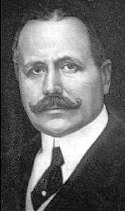George Dunton Widener
George Dunton Widener | |
|---|---|
 George D. Widener | |
| Born | June 16, 1861 |
| Died | April 15, 1912 (aged 50) |
| Cause of death | Drowning |
| Resting place | North Atlantic Ocean 41°43′55″N 49°56′45″W / 41.73194°N 49.94583°W |
| Occupation | Businessman |
| Board member of | Philadelphia Traction Co., Land Title Bank and Trust Co., Electric Storage Battery Co., Portland Cement Co., Pennsylvania Academy of Fine Arts |
| Spouse | Eleanor Elkins |
| Children | Harry Elkins (1885-1912) George Dunton Jr. (1889-1971) Eleanor (1891-1953), married Fitz Eugene Dixon, 1912 |
| Parent | Peter A. B. Widener & Hannah Josephine Dunton |
George Dunton Widener (June 16, 1861 - April 15, 1912) was an American businessman who died in the sinking of the RMS Titanic.
Biography
Born in Philadelphia, he was the eldest son of Hannah Josephine Dunton (1836-1896) and the extremely wealthy streetcar magnate Peter A. B. Widener (1834-1915).
George D. Widener joined his father's business and eventually took over the running of the Philadelphia Traction Company, overseeing the development of cable and electric streetcar operations. He also served on the board of directors of several important area businesses. A patron of the arts, Widener was a Director of the Pennsylvania Academy of Fine Arts.
In 1883, he married Eleanor Elkins, the daughter of his father's business partner, William Lukens Elkins. They had two sons, Harry Elkins Widener (1885-1912), George Dunton Widener, Jr. (1889-1971), and a daughter, Eleanor Widener Dixon (1891-1953). The family lived at Lynnewood Hall, his father's 110-room Georgian-style mansion in Elkins Park, Pennsylvania.
In 1912, George D. Widener, his wife, and their son Harry traveled to Paris, France, with original intentions to find a chef for Widener's new Philadelphia hotel, The Ritz Carlton. The Wideners booked their return passage on RMS Titanic. After the ship struck an iceberg, Widener placed his wife and her maid in a lifeboat. The women were rescued by the steamship RMS Carpathia, but George D. Widener and his son Harry both went down with the ship. Their bodies, if recovered, were not identified. A memorial service for them was held at St. Paul's Episcopal Church in Elkins Park, Pennsylvania where stained glass windows were dedicated in their memory. Two weeks after their untimely deaths on the Titanic, Widener's daughter Eleanor married Fitz Eugene Dixon at the family estate in Elkins Park, Pennsylvania.

George Widener had commissioned Horace Trumbauer to design and oversee construction of Miramar, a 30,000-square-foot (2,800 m2) French neoclassical-style mansion bordering Bellevue Avenue on Aquidneck Island at Newport, Rhode Island. Intended as a summer home, it was still in the design stage at the time of his death.[1]
His widow donated the Harry Elkins Widener Memorial Library to Harvard University in memory of their son. His brother, Joseph E. Widener, became a founding benefactor of the National Gallery of Art in Washington, D.C. George Jr. bought Erdenheim Farm, and became a major figure in thoroughbred racing. His only grandchild, Fitz Eugene Dixon, Jr. (1923-2006), became a noted philanthropist and owner of Philadelphia sports teams.
Legacy in popular culture
George D. Widener was played by Guy Standing, Jr. in the 1953 film Titanic.
References
- Mr George Dunton Widener, Encyclopedia Titanica
- Titanic: Triumph and Tragedy, by John P. Eaton and Charles A. Haas, W.W. Newton & Company, 2nd edition 1995 ISBN 0-393-03697-9
- A Night to Remember, by Walter Lord, ed. Nathaniel Hilbreck, Owl Books, rep. 2004, ISBN 0-8050-7764-2
